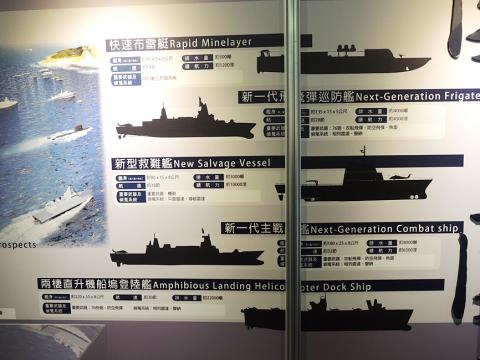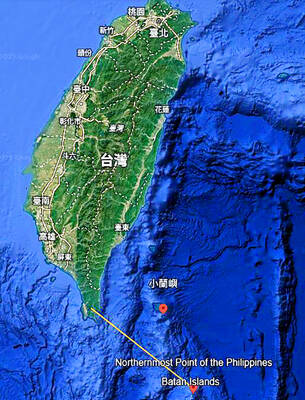The navy has proposed building a helicopter carrier as part of its indigenous shipbuilding program to boost the nation’s marine-patrol capabilities.
The navy plans to build a Landing Helicopter Dock capable of carrying six large helicopters and traveling at 30 knots (55kph).
The 22,000 tonne, 220m-long carrier would be fitted with an OTO Melara 76mm gun, an air defense missile system, an active electronically scanned array radar and advanced sonar system, the navy said.

Photo: Lo Tien-pin, Taipei Times
The announcement of the proposal coincided with a naval indigenous shipbuilding exhibition that opens today on the AOE 532 Panshi, a combat-support ship that docked in Keelung Harbor yesterday.
It is the first public presentation of the project since the navy unexpectedly scrapped its helicopter carrier plans from a program unveiled during the Kaohsiung International Maritime and National Defense Exhibition last year.
However, the navy said the plan is yet to be formally included in its shipbuilding scheme pending government approval.
“The presentation shows the navy’s ‘vision’ for a helicopter carrier, but whether it becomes a reality depends on government evaluations,” the navy said.
The navy has also planned to build rapid minelayers, salvage vessels, next-generation frigates and combat ships, minesweepers, submarines, amphibious dock vessels, multi-functional transport ships and more Tuo Jiang-class corvettes.
The Panshi sailed into the harbor yesterday along with a Cheng Kung-class frigate and a Kang Ding-class frigate, and is to be open to the public today and tomorrow from 9am to 3pm.
However, only Taiwanese with national ID cards are allowed to board the ships.
Meanwhile, Deputy Minister of National Defense Lee Hsi-ming (李喜明) rejected speculation that the government was planning to purchase a decommissioned Japanese submarine because the navy had difficulties building its first locally-designed submarine.
According to a Hong Kong media report, the ministry planned to purchase a retired Harushio-class or Oyashio-class diesel-electric submarine from Japan under the pretext of “importing scrap metal,” because the navy failed to secure the technology to build a submarine hull from the Netherlands, which built the navy’s two Chien Lung-class submarines, and other European countries.
“There is no such things and media speculation is incorrect,” Lee said.
The ministry was proceeding with the shipbuilding program, but much of the program is confidential and unsuitable for public discussion, he said.

SECURITY: As China is ‘reshaping’ Hong Kong’s population, Taiwan must raise the eligibility threshold for applications from Hong Kongers, Chiu Chui-cheng said When Hong Kong and Macau citizens apply for residency in Taiwan, it would be under a new category that includes a “national security observation period,” Mainland Affairs Council (MAC) Minister Chiu Chui-cheng (邱垂正) said yesterday. President William Lai (賴清德) on March 13 announced 17 strategies to counter China’s aggression toward Taiwan, including incorporating national security considerations into the review process for residency applications from Hong Kong and Macau citizens. The situation in Hong Kong is constantly changing, Chiu said to media yesterday on the sidelines of the Taipei Technology Run hosted by the Taipei Neihu Technology Park Development Association. With

CARROT AND STICK: While unrelenting in its military threats, China attracted nearly 40,000 Taiwanese to over 400 business events last year Nearly 40,000 Taiwanese last year joined industry events in China, such as conferences and trade fairs, supported by the Chinese government, a study showed yesterday, as Beijing ramps up a charm offensive toward Taipei alongside military pressure. China has long taken a carrot-and-stick approach to Taiwan, threatening it with the prospect of military action while reaching out to those it believes are amenable to Beijing’s point of view. Taiwanese security officials are wary of what they see as Beijing’s influence campaigns to sway public opinion after Taipei and Beijing gradually resumed travel links halted by the COVID-19 pandemic, but the scale of

A US Marine Corps regiment equipped with Naval Strike Missiles (NSM) is set to participate in the upcoming Balikatan 25 exercise in the Luzon Strait, marking the system’s first-ever deployment in the Philippines. US and Philippine officials have separately confirmed that the Navy Marine Expeditionary Ship Interdiction System (NMESIS) — the mobile launch platform for the Naval Strike Missile — would take part in the joint exercise. The missiles are being deployed to “a strategic first island chain chokepoint” in the waters between Taiwan proper and the Philippines, US-based Naval News reported. “The Luzon Strait and Bashi Channel represent a critical access

Pope Francis is be laid to rest on Saturday after lying in state for three days in St Peter’s Basilica, where the faithful are expected to flock to pay their respects to history’s first Latin American pontiff. The cardinals met yesterday in the Vatican’s synod hall to chart the next steps before a conclave begins to choose Francis’ successor, as condolences poured in from around the world. According to current norms, the conclave must begin between May 5 and 10. The cardinals set the funeral for Saturday at 10am in St Peter’s Square, to be celebrated by the dean of the College